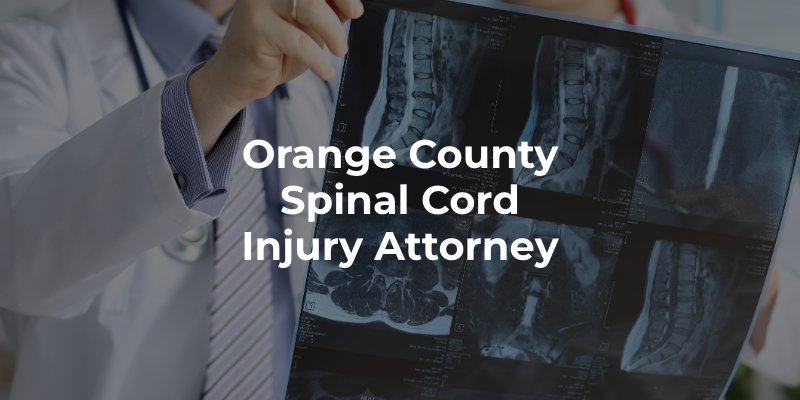Our attorneys have been assisting the Orange County and Southern California communities for over 40 years.
A spinal cord injury is a serious matter. A County spinal cord injury lawyer at DiMarco | Araujo | Montevideo can help you and your loved ones during this difficult time. Our Orange County personal injury attorneys have been working diligently for spinal cord injury victims and helping them receive the compensation they are rightfully entitled to for over three decades.
Get started today by scheduling a free consultation.
 At the law offices of DiMarco | Araujo | Montevideo, we will provide you and your family with a comprehensive team of experienced spinal cord injury attorneys, physicians, economists, vocational experts, staff, and accident reconstructionists who will work together to fully represent your case and maximize the recovery you are awarded by the judge, jury, or insurance company.
At the law offices of DiMarco | Araujo | Montevideo, we will provide you and your family with a comprehensive team of experienced spinal cord injury attorneys, physicians, economists, vocational experts, staff, and accident reconstructionists who will work together to fully represent your case and maximize the recovery you are awarded by the judge, jury, or insurance company.
Reaching Maximum Medical Improvement (MMI) should be the number one goal for you. We will look out for your legal rights and fight your case in court. Our firm wants you to get fair compensation for your spinal cord injuries and all related expenses and missed opportunities.
Your case will be well represented, as even the Better Business Bureau gave us their highest possible rating of an A+.
Since 1979, the insurance and legal communities have come to know our work and respect us and our ethical and winning standards. Our firm has consistently given back to the community. That community development, along with our firm’s legal experience and name recognition, are all unique advantages you receive as a client of our work injury law firm.
Our successful reputation as spinal cord injury lawyers in Orange County speaks for itself: We will provide you with quality representation for your injury case. This is true whether it is a workers’ compensation, work injury, or personal injury case. We will investigate all spine injuries to make sure your case’s scope is maximized, including looking at all the details for the possibility of adding a third-party claim.
“Very straight forward with how things worked, no hidden surprises. Really glad we found them – now we can close that stressful chapter of our lives!” -L. P.

The spinal cord is protected by the spine but there are plenty of traumatic and common reasons for how it gets injured. A spinal cord injury (SCI) is defined as harm or damage to the spinal cord that causes a loss of function. The possible functions that may be decreased or lost include feeling, balance, and mobility. One of the main symptoms of spinal cord injuries is loss of movement or paralysis.
The spinal cord is actually the soft bundle of nerves that goes from the lower back all the way up to the brain. It runs through what is called the spinal canal for protection. The spinal cord is considered the “information highway” between your brain and your entire body as it sends and carries the directions that come from the brain to the main parts of the body.
When someone has totally lost the ability to use a specific area of the body because of a spinal cord injury, it is referred to as a complete injury. It is referred to as an incomplete injury if someone still has partial use of the body area after being the victim of a spinal cord injury.
There are various types of spinal cord injuries that can occur. Most commonly, individuals know that spinal cord injuries are divided into:
Spinal cord injuries are divided into “complete” or “incomplete” definitions. When a person sustains an incomplete spinal cord injury, they retain some movement or sensation in their limbs. When a person sustains a complete spinal cord injury, they are completely paralyzed below the site of the injury. Complete spinal cord injuries typically result in permanent paralysis.
Spinal cord injury victims in Orange County will likely be entitled to various types of compensation if their injury was caused by the careless or negligent actions of another party. Our attorneys work diligently to cover both economic and non-economic damages on behalf of every client that we help.
Economic damages are also referred to as “special damages,” and these are the quantifiable expenses that a person incurs in the aftermath of sustaining a spinal cord injury. These are quantifiable because we can gather bills and receipts that come in after the injury occurs to determine total losses. Some of the most common economic damages for a spinal cord injury case in Orange County include the following:
Non-economic damages are also referred to as “general damages,” and these are harder to quantify than the economic costs mentioned above. There may not be any bills or receipts that can be directly attributed to a person’s physical pain and suffering, emotional and psychological distress, and loss of enjoyment of life after a spinal cord injury occurs.
However, just because these injuries are not as quantifiable does not mean that they are not real. An attorney will work diligently to establish non-economic losses on behalf of a client so they can recover total compensation.
In California, you typically have two years from the date of the spinal cord injury to file a personal injury claim. This deadline is set by the state’s statute of limitations.
If your injury was caused by a government agency, such as in a public transportation accident or unsafe public property, you may have only six months to file an administrative claim. Missing the deadline could mean losing your right to compensation, so it’s important to speak with a personal injury lawyer as soon as possible.
Turning to the National Spinal Cord Injury Statistical Center (NSCISC), we can see just how expensive the total cost of medical care after a spinal cord injury can become. According to their information, individuals who sustain a spinal cord injury that leads to quadriplegia will likely experience first-year medical costs rising above $1.1 million. The data shows that every subsequent year of medical care after the first year will likely rise above $200,000.
Those who sustain less severe spinal cord injuries may not pay as much in medical expenses, but even a minor spinal cord injury typically results in medical bills reaching approximately $380,000 for the first year of care and more than $46,000 for every subsequent year.
However, these are only medical costs. When examining the total cost of recovery after a spinal cord injury, we also have to look at:
According to the Spinal Cord Injury Resource Center, fewer than half a million people in the United States have spinal cord injuries. There are about 10,000 new SCI’s every year, and the vast majority of these new spinal cord injuries have external causes to blame.
The top three causes are: auto accidents (36%), violence (28.9%), and slipping and falling (21.2%).
We have represented spinal cord injury victims for over three decades, with many of these injuries caused by one of the following:
No matter the cause, we promise that our entire firm will be on your side throughout your spinal cord injury case.
Treatment for spinal cord injuries depends on the location and severity of the damage. Initially, emergency care focuses on preventing further harm — stabilizing the spine, ensuring proper breathing, and managing potential complications involving the heart, lungs, or bladder.
Patients are typically treated in an intensive care unit (ICU) by a team that may include surgeons, neurospecialists, therapists, and social workers. Treatments can involve medications like corticosteroids, spinal surgery to relieve pressure or remove bone fragments, and stabilization tools such as neck collars or traction devices.
Rehabilitation is often a long-term process involving physical and occupational therapy to help regain mobility and independence. Results vary based on the extent of the injury and individual health factors.
Life expectancy for people with a spinal cord injury (SCI) varies significantly based on the severity and location of the injury, as well as the age and overall health of the individual. Advances in medical care and rehabilitation have improved outcomes, but SCI can still reduce life expectancy compared to the general population.
People who are injured young can enjoy relatively long life expectancies, ranging from approximately 83% of normal life expectancy for people with minimal deficit incomplete injuries to approximately 50% of normal life expectancy in high-cervical-level injuries without ventilator dependence.
Over our 30+ years of experience, we have witnessed just how hard spinal cord injuries can be on a person and their family. It is time to get the compensation you and your family rightfully deserve to cover medical expenses, lost income, property damage, and much more. Our firm fully believes in complete customer service, starting with the free initial consultation. This includes our pledge that we will come to you when you cannot make it to our office.
We offer free consultations to review your case and discuss your legal options. You will meet with a personal injury attorney who will listen to your entire case, answer all of your questions, give you legal advice, and guide you through the legal process. You will not incur any legal fees or expenses for our assistance or time unless and until we win for you a positive trial verdict or settlement.
If you cannot travel to meet us, the Orange County spinal cord injury attorneys at DiMarco | Araujo | Montevideo are ready to have a meeting with you at our office, your home, or your hospital room.
Contact us today at (714) 783-2205 or fill out our contact online form.